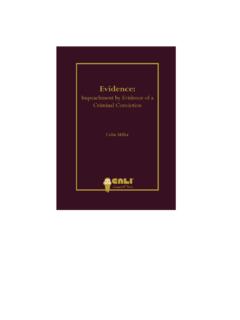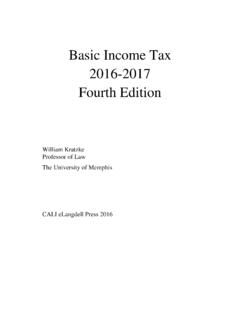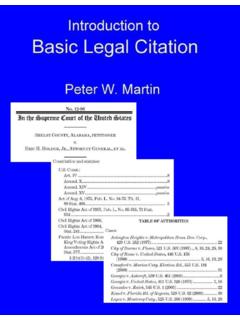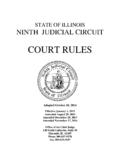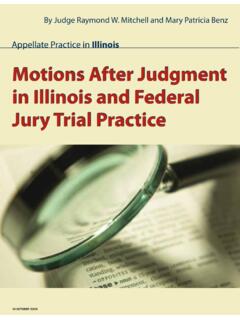Transcription of Evidence: Propensity Character Evidence - CALI
1 Evidence : Propensity Character Evidence Colin Miller The John Marshall Law School CALI eLangdell Press 2013 iii About the Author Professor Miller teaches Evidence , Criminal Procedure, Criminal Law, and Civil Procedure. He is the creator and Blog Editor of EvidenceProf Blog of the Law Professor Blogs Network. He is the Editor of illinois Criminal Procedure and drafted a 100 page report comparing the Federal rules of Evidence to illinois evidentiary principles, which was used in the creation of the first illinois rules of Evidence . Professor Miller received his degree with distinction from the University of Virginia and his (Order of the Coif) from the William & Mary Law School.
2 Ii Notices This work by Colin Miller is licensed and published by CALI eLangdell Press under a Creative Commons Attribution- ShareAlike Unported License. CALI and CALI eLangdell Press reserve under copyright all rights not expressly granted by this Creative Commons license. CALI and CALI eLangdell Press do not assert copyright in US Government works or other public domain material included herein. Permissions beyond the scope of this license may be available through In brief, the terms of that license are that you may copy, distribute, and display this work, or make derivative works, so long as you give CALI eLangdell Press and the author credit; you do not use this work for commercial purposes; and you distribute any works derived from this one under the same licensing terms as this.
3 Suggested attribution format for original work: Colin Miller, Evidence : Propensity Character Evidence , Published by CALI eLangdell Press. Available under a Creative Commons BY-SA License. CALI and eLangdell are United States federally registered trademarks owned by the Center for Computer-Assisted Legal Instruction. The cover art design is a copyrighted work of CALI, all rights reserved. The CALI graphical logo is a trademark and may not be used without permission. Should you create derivative works based on the text of this book or other Creative Commons materials therein, you may not use this book s cover art and the aforementioned logos, or any derivative thereof, to imply endorsement or otherwise without written permission from CALI.
4 Iii This material does not contain nor is intended to be legal advice. Users seeking legal advice should consult with a licensed attorney in their jurisdiction. The editors have endeavored to provide complete and accurate information in this book. However, CALI does not warrant that the information provided is complete and accurate. CALI disclaims all liability to any person for any loss caused by errors or omissions in this collection of information. About CALI eLangdell Press The Center for Computer-Assisted Legal Instruction (CALI ) is: a nonprofit organization with over 200 member US law schools, an innovative force pushing legal education toward change for the better.
5 There are benefits to CALI membership for your school, firm, or organization. eLangdell is our electronic press with a mission to publish more open books for legal education. How do we define "open?" Compatibility with devices like smartphones, tablets, and e-readers; as well as print. The right for educators to remix the materials through more lenient copyright policies. The ability for educators and students to adopt the materials for free. Find available and upcoming eLangdell titles at Show support for CALI by following us on Facebook and Twitter, and by telling your friends and colleagues where you received your free book.
6 2 Table of Contents About the Author .. iii Notices .. ii About CALI eLangdell Press .. 1 Propensity Character Evidence .. 3 I. A Definition of Propensity Character Evidence .. 3 II. Common Law Origins of the Propensity Character Evidence Proscription .. 3 A. England .. 3 B. United States .. 4 III. Federal rules of Evidence .. 7 A. Federal Rule of Evidence 404(a)(1) .. 7 B. Federal Rule of Evidence 404(a)(2) The Mercy Rule .. 9 1. Rule 404(a)(2): Injecting Propensity Character Evidence Into a Criminal Trial .. 9 2. Rule 405(a) Methods of Proving Character Under the Mercy 14 C. Federal Rule of Evidence 405(b) Character In Issue 23 IV.
7 Character Evidence Motions .. 28 3 Propensity Character Evidence I. A Definition of Propensity Character Evidence Propensity Character Evidence is the use of Evidence of a person s Character or trait of Character to prove that he has a Propensity to act in a specific manner and thus that he likely acted in conformity with that Propensity at the time of an alleged pre-trial wrong. For instance, Evidence that a defendant charged with a crime of violence had a reputation for being violent would be Propensity Character Evidence . This is because it would be used to prove his Propensity for acting violently and his likely conformity with that Propensity at the time of the crime charged.
8 Alternatively, Propensity Character Evidence can be defined more simply as Evidence whose probative value depends upon the aphorism, [o]nce a criminal, always a criminal, such as Evidence that a person on trial for robbery had committed robberies before ( Once a robber, always a robber. ). See Alegata v. Commonwealth, 231 201, 209 (Mass. 1967) ( The concept of once a criminal always a criminal is abhorrent to our law. ). II. Common Law Origins of the Propensity Character Evidence Proscription A. England In England, before the 17th Century, courts admitted almost any type of Evidence , with the only limitation being rules deeming certain categories of individuals incompetent to testify.
9 All other forms of Evidence were admissible under the inquisitorial system, which had reigned in England since the Norman Conquest and which found an evidentiary code unnecessary. Under the inquisitorial system, it was not considered irregular to call witnesses to prove a prisoner's bad Character in order to raise a presumption of his guilt. John H. Langbein, The Origins of Adversary Criminal Trial 190-91 (2003). 4 This open door policy with regard to Propensity Character Evidence could be explained by the inquisitorial system s assumption that the accused committed a crime and the concomitant requirement that he affirmatively prove his innocence.
10 One of the most conspicuous consumers of Propensity Character Evidence , and ultimately the harbinger of its death, was The Court of Star Chamber. Established in 1487, the Star Chamber was an expeditious way for the Tudors and Stuarts to exorcise political and religious dissenters of the monarchy while masquerading as a court conducting treason trials. The Star Chamber was the Crown s organ of terror, renown[ed] among the citizenry for its arbitrary and cruel decisions, and one of its most capricious practices was the deluge of Character Evidence it admitted, resulting in defendants being punished for their sordid Character rather than their culpable conduct.
